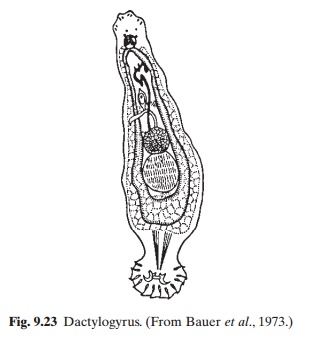Chapter: Aquaculture Principles and Practices: Health and Diseases
Trematode infections of aquaculture species
Trematode infections
Among the other major causes of infection of importance in aquaculture
are larvae of trematodes. Dactylogyrosis is a common disease caused by species
of the genus Dactylogyrus, or the
gill fluke, which affects common carp, Chinese carps and other fish. Dactylogyrus is small in size (rarely
longer than 1 mm) and occurs on the gill filaments (fig. 9.23). A number of
species have been identified, but the ones of epizootic interest for carp
appear to be D. vastator and D. extensus. They attach themselves to the
gills and, under favourable conditions, such as temperatures below 30°C,
develop rapidly. They are hermaphrodites and lay eggs that fall to the bottom
of the pond or other rearing facilities. The larvae which hatch out are ciliate
and swim around until they attach themselves to the gills, body surface or oral
cavity of a host and begin to grow. Irrespective of the place of initial
attachment, they all subsequently congregate on the gills and, when mature,
start laying eggs, repeating the life cycle. Dactylogyrus vastator seems to prefer warm-water environments and
infects mainly young carp, causing heavy mortality depending on the intensity
of infection.

Dactylogyrus extensus, on the other hand,prefers temperatures below 17°C. In addition, this
species occurs in both young and adult fish and is more pathogenic. The
intensity of infection increases with the age of the host. In both cases, older
fish are the source of infection. Infected fish become restless and collect
near water outlets. The gills are damaged and become covered with mucus,
inhibiting normal respiration.
The infections can be controlled by the usual sanitary measures in pond farms. Ammonia baths are recommended for treatment, at concentrations of 2 ml of 25 per cent ammonia solution per litre water for half to one minute.
Bromex-50 and Dipterex have also been used successfully.
The species of Dactylogyrus
infecting grass carp have been identified as D. lamellatus and D.
ctenopharyngodonis. Dactylogyrus
hypophthalmichthys is the common parasite of silvercarp and D. aristichthys and D. nobilis of bighead and Chinese carp hybrids. They do not appear
to infect other pond fish. The symptoms of the disease are generally very similar
and the treatment recommended is also the same.
Related Topics